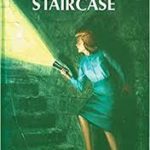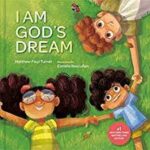It’s that time of year again! Book award season is upon us! 2022 was a GREAT year for Christian children’s books. Both Christianity Today and The Gospel Coalition give awards for the best in faith-market children’s literature. However, just because these two Christian-culture-juggernauts say you should have a book in your book basket, doesn’t necessarily mean it’s right for every family. Read on for a picky-mom review of EVERY winner and finalist in their children’s categories.
Under each title, I have a short section where I list “Reasons the award was deserved,” where I say the absolute best thing about the title, and why I think it was recognized. Then, I have a section with an “Unsolicited opinion from me.” That’s pretty self explanatory…y’all know I have thoughts!
This year there are some really wonderful books that won awards, so I hope my additional thoughts about each title will help you choose the best Christian picture books of 2022 for your book basket!
(Heads up that Christianity Today calls their book awards the 2023 awards, but it’s for books that were published in 2022. The Gospel Coalition calls their books awards the 2022 Book Awards. Just an FYI so you aren’t confused when you see both 2023 and 2022 – this is all for books published in 2022.)
This post contains referral links for these products. As an Amazon Associate I earn from qualifying purchases. It does not cost you extra to purchase through my links.
Who won the youth categories of Christianity Today’s 2023 Book Awards?
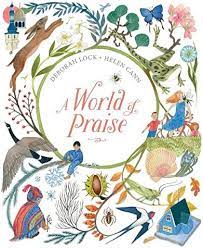
A World of Praise – Winner, Children
By Deborah Lock, Illustrated by Helen Cann
Reasons the award was deserved: With lyrical (but not rhyming!) words, and stunning colorful pictures, this picture book is a song of thanksgiving. It is rather hefty for young children at 48 pages long, and could be used as separate prayers, or as one long hymn.
Unsolicited opinion from me: I think this is a beautiful liturgy thanking God for everything, across all the continents. Plus, the pictures are gorgeous. It’s definitely not meant just for kids, and certainly will appeal to grownups.
There are the occasional references to God being “in everything,” or, “in (something in nature).” I know not all families love that type of wording, and I switched it up to “WITH everything,” when I read it aloud, just because it’s my preference to avoid confusion with the kids. (“Is God in my cookie? Am I eating God?” We do our best to stay FAR away from heresy over here.)
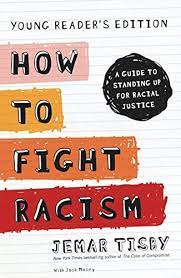
How to Fight Racism Young Reader’s Edition: A Guide to Standing Up for Racial Justice – Award of Merit, Children
By Jemar Tisby
Reasons the award was deserved: Social justice issues should be important to all Christians. How to Fight Racism Young Reader’s Edition has strong sections explaining that diversity was always part of God’s plan for his children, and that it’s a wonderful thing. Tisby also gives a well written (though understandably not complete) history of racism in America, with focus on racism in the church.
Also, the questions to consider at the end of each chapter are definite high points. You know how some books’ questions feel like an unnecessary add-on? Not here – they’re thought provoking, but with age appropriate suggestions and action steps. Many of his suggestions feel very “doable” for tweens and teens. For example, just don’t laugh when someone tells a racially motivated joke.
Unsolicited opinion from me: The publisher recommends this book for 8 to 12 year olds. There are a few charts and specific paragraphs of the book that I don’t think got the full “young reader edition” treatment, and I think that age range is too young to engage purposefully with the text. (I am aware that I am an outlier in that belief among those who have reviewed this title. I stand by what I said, and I’ll say it again: 8 is too young.)
Here are a few (of several) quotes that I noted while I was reading it, that I’d want to know about before I purchased this book for my kid. It will give you an idea of the overall vibe of the book:
“Even though racism is not something invented by Black people or other people of color, we still have a responsibility to fight racism. White people are the ones who benefit, in some ways, from racism. So white people have a lot of responsibility to fight racism.”
“Anyone deemed nonwhite falls outside the highest level of the racial ranking system; the darker-skinned a person, the lower their position in society. … This is why even when they were the President and First Lady of the United States, Barack and Michelle Obama endured racist attacks. No matter their level of achievement, people of African descent in the United States, especially those with darker skin, are always placed in the outermost ring of American social circles.”
“Since white people are in charge of how society is organized, they have a way of making the rules so they always get the best options and opportunities.”
Related: Christian picture books about race, reviewed by a picky mom
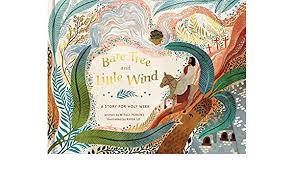
Bare Tree and Little Wind: A Story for Holy Week – Finalist, Children
By Mitalki Perkins, illustrated by Khoa Le
Reasons the award was deserved: What a unique way to tell a deeper scriptural truth! The premise of the story is that there is a tree in Jerusalem bearing witness to the time of Jesus and the hard years after his death. The overall theme of the story is that the truth of Jesus spread after his ascension and will continue to spread, forever, and ever, amen.
Unsolicited opinion from me: I really like this book. Way back when it came out I added it to my list of excellent Easter books. The only thing that irks me is that it never uses the name, “Jesus,” and instead the text calls him, “quiet man.” That’s not my thing, I’d like my kids to understand who we’re talking about and not have to guess, so I changed it to “Jesus” in our copy of the book. Other than that, it’s lovely. (I also liked another book by Perkins that came out this year, The Story of Us. Her writing style is definitely more abstract/touchy-feely, just a heads up.)
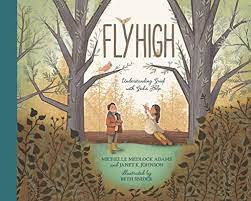
Fly High: Understanding Grief With God’s Help – Finalist, Children
By Michelle Medlock Adams and Janet K. Johnson, illustrated by Beth Snider
Reasons the award was deserved: A strength of this picture book about grief is that the story is about children mourning the death of a bird, but the questions and discussion is about children mourning the death of a loved one. So, it doesn’t matter who the child lost, be it parent, friend, grandparent, or even pet, this book will be appropriate.
There are also two different fonts in the book, one that is the story portion, and one that is the more discussion and question portion. You could use one or the other, or both, depending on what your child wanted to talk about that day. I found all of the questions to be gentle, but also not shying away from the reality of the child’s loss. They also walk through the stages of grief, which was unexpected, but a welcome acknowledgment of children’s ability to be active participants in a family processing grief.
Unsolicited opinion from me: This is a wonderful resource. Many have tried to create an accessible resource that Biblically explains loss due to death to young children, and this is the most successful one I’ve ever read, by far.
Heads up that there is no mention of the afterlife in this picture book. I actually consider that a massive point in favor of this book, because it’s weird when picture books say things like, “They’re looking down on you right now!” or, “They got their wings!” when that might not be your family’s or denomination’s beliefs about how heaven works.
The only thing that even gave me a smidge of pause is one line that implies that our actions that hurt people when we’re grieving are not our fault. (You’ll know it when you read it.) I disagree with that, so instead of saying, “it’s not your fault,” if I were reading it aloud, I would say, “it’s not your fault that you feel that way, and acting out is something that everyone does sometimes.” Or something like that. But that’s being REALLY picky.
Overall, I HIGHLY recommend it. I think you could use it as a springboard to discussion with any age, but the sweet spot is probably 4 to 8 years old. You could definitely push that age older if it’s a less mature child, or a child who’s really struggling to open up about their loss. Honestly, I feel like it has some good reminders for grown ups, too.

Who Am I and Why do I Matter? – Winner, Young Adults
By Chris Morphew, illustrated by Emma Randall
Reasons the award was deserved: Identity is such a crucial issue for all of us, but especially our young people. Morphew lays out where our true identity comes from, and how nothing can change that we are God’s image bearers and deeply loved by him.
Also, there’s a definite focus in the book on replacing fear or anxiety with the self-confidence that comes from knowing God and how he feels about you. So many anxious tweens and teens need this message!
I also appreciate that it is not written for a gender specific audience, and all students should be engaged and enjoy it.
Unsolicited opinion from me: It’s great. Deep, but not suffocating or preachy. I highly recommend it for ages 11 and up. (The publisher recommends for ages 9 through 13. Although I think it would resonate with a very mature 9 year old, the older ages will get it even more. I also think that “worth” is a complex issue with today’s kids that lasts long past middle school, so you could definitely use this resource with high schoolers who need this message.) Also, there’s a really nice free discussion guide from the publisher if you’re working through the book with your child or a small group.
Related: Christian Comic Books for Tween Boys
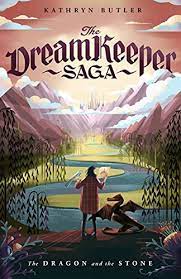
The Dragon and the Stone – Award of Merit, Young Adults
By Kathryn Butler
Reasons the award was deserved: I love a good read aloud story that is appropriate for the whole family, and this one knocks it out of the park. The pacing is fast, the premise is engaging, the fantasy is imaginative but not hard to follow, and there’s even a beautiful allegory of the redemption story. Love it, five out of five stars, ten out of ten high-fives, it deserves every award it gets.
Unsolicited opinion from me: The Dragon and the Stone absolutely was a standout this year. I gave it the Golden Paw Print award as best Christian children’s audiobook of the year. It’s also a great read aloud, and I’d feel comfortable giving it to my child to read independently.
The only “ehh” thing in the entire book is that it does have that familiar trope of, “the bully is actually super misunderstood and has a bad home life, and that sort of makes it better!”
Although this is a common literary plot point in children’s books, it’s not necessarily healthy for kids to internalize, especially if they are being bullied. It’s never ok for someone to bully you, no matter how crappy their home situation is. So, my one caveat is I wouldn’t let a child who’s being bullied read it without a few conversations about the fact that nothing justifies horrible behavior to another human being.
Also, heads up that there are some very real scary situations in the book. A father dies, they talk about a traumatic divorce of one character’s parents, the bad creatures are BAD. I read it aloud to my 10 and 6 year olds with no problems, and one of them is a sensitive listener, but do preview before you start reading it aloud, or before you give it to a sensitive listener.
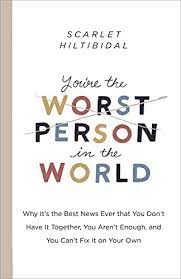
You’re the Worst Person in the World – Finalist, Young Adults
By Scarlet Hiltibidal
Reasons the award was deserved: The overall message is summed up in this quote that I highlighted, and might get tattooed on my face, idk, seems important:
“There are only bad people and a gracious God. He wants to give us real grace…He wants our thirsty hearts to be deeply satisfied in Him so that we may say, ‘In your presence there is fullness of joy; at your right hand are pleasures forevermore’ (Ps. 16:11 ESV).”
This book is for all the perfectionists out there, those good kids who became good adults, raising good kids…and absolutely losing it every time they aren’t perfect.
I appreciated that the message was grace, but not to the point of glamorizing sin. It’s about celebrating grace, but not using it as an excuse to be crappy parents.
Unsolicited opinion from me: I really liked this book. (Full disclosure, I didn’t read every word of it, so if you’re like, “Uhh, there’s heresy on page 94,” my bad. What I read and what I know of the author make me think the theology is fine.)
So, I thought it was great. However, I am beyond baffled that someone thought it should be put up for the YA award. Like…what?
There are references to parenting. And sections about being content while looking for a spouse and being married. The style is clearly, “hey, young-fellow-mom friend, let’s chat about JESUS!”
Also, the publisher literally markets it as for adults. It will be stocked in the women’s inspiration section of your local bookstore.
Was this a “I think we can do better in this category” thing? Maybe. I don’t know. What I do know is it’s clearly not written for a YA audience. There’s nothing that I thought would be inappropriate for YA readers, but also nothing that made me think they’d connect with it. I’d say college age and up women is definitely the target audience.
So, I HIGHLY recommend it…for the right audience.
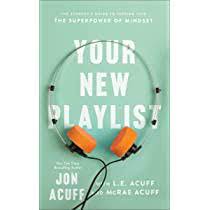
Your New Playlist: The Student’s Guide to Tapping Into the Superpower of Mindset – Finalist, Young Adults
By Jon Acuff, L. E. Acuff, and McRae Acuff
Reasons the award was deserved: The tone of the book is humorous and conversational. However, the topic is serious and life-changing: mindset.
The book’s aim is to teach readers to use their minds and self-talk to propel them to success. That’s a pretty common theme in YA self-help books these days. The thing about THIS self-help book that I immediately picked up on and cheered about is that it doesn’t assume that whatever the teen thinks is automatically the right path.
Acuff says, “One of the greatest mistakes you can make is assuming that all your thoughts are true. Despite the lies our thoughts have told us over and over again, we tend to believe that if we think something, it must be true. If it’s in our head, it must be fact. But what if it’s not?”
Unsolicited opinion from me: I liked everything that this book had to share, I’d be very comfortable with my tween or teen reading this book. In fact, I’d encourage them to read it.
My only “ehh” with it isn’t what’s in it, it’s what’s missing – any mention of where real truth comes from.
I wouldn’t classify this book as Christian at all. It does share truth, but there’s no mention of getting good self-talk from the Bible, or prayer, or any spiritual anything. Without that, teens could still be left in the vacuum of taking Acuff’s word for what “good” self-talk is. So, while I recommend this title, I would classify it as a secular book, and I’d want to sprinkle in a few Bible verses on sticky notes before I hand it to my tween or teen.
Who won the children’s categories of The Gospel Coalition 2022 Book Awards?
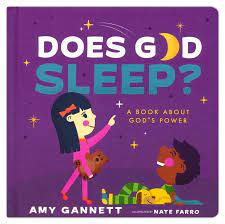
Does God Sleep?: A Book About God’s Power – Children’s, Winner
By Amy Gannett, illustrated by Nate Farro
Reasons the award was deserved: It is amazing that our God needs no rest, isn’t it? He is ALL powerful, ALL the time. I definitely take that for granted.
This sweet rhyming board book simply explains that God doesn’t need sleep, and why that moves us to worship him.
Unsolicited opinion from me: Because of the rhyming prose and sparse text, I recommend this for toddlers and very young preschoolers only. One of my kids even said, “Why don’t they use the big word?”
I think he was talking about “omnipotence,” or something like that, but the point is that the vocabulary level is extremely low.
The theology is SPOT ON, so if your toddler does have questions about God, I do recommend the whole series of board books from this author about the attributes of God. However, if your child understands the very basic point that God is all powerful, this particular board book won’t break any new ground.
Related: Looking for some board books with theology? These are the best gospel board books.
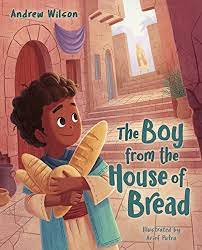
The Boy from the House of Bread – Children’s, Award of Distinction
By Andrew Wilson, illustrated by Arief Putra
Reasons the award was deserved: Bethlehem literally means, “House of Bread.” So, the theme of the story is about Jesus being the bread of life, and giving bread, and being broken like bread. There’s a lot of carb metaphors. It’s a unique take on a beautiful truth.
As I’ve mentioned, I’m not crazy about rhyming books right now, but this one is nice. Even though it’s rhyming, it would be suitable for a wider age range of kids. It’s more poetic and free-verse than many rhyming picture books, and sort of feels like an old chant telling a story, or something like that. Although I personally like that, it could be jarring if you’re reading aloud, so just a heads up.
The line that won me over to the rhyme was, “They’d murdered the man who could multiply bread, and the hope of the world was dead.”
Unsolicited opinion from me: If I was asked, I’d classify this book as an Easter story. I don’t think the author intended it that way, especially because it came out in July, but it captures so well the despair that Jesus’ death would have caused. I recommend it as a Lent read aloud, suitable for all ages, as long as they’re ok with the part where John the Baptist is beheaded…maybe skip that with littles. With the big kids, just chew more on the metaphor of bread. (Get it…chew?)
One thing that makes me say, “hmmm,” is the book shrinks the number of players in the Bible stories. The main character, Alex, just so happens to be the boy with the loaves and fishes. And, coincidentally, his dad is the one who carries the cross for Jesus. Oh, and while we’re at it, Alex is friends with the women who go to the tomb so he was with them and saw the angels. Busy family.
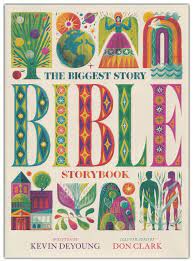
The Biggest Story Bible Storybook – Bible Studies and Devotional Literature, Award of Distinction
By Kevin DeYoung, illustrated by Don Clark
Reasons the award was deserved: As a large family with a wide age range of kids, it can be a challenge to find books that are deep enough to stretch our big kids, but simple enough for our little kids. This Bible storybook is excellent for all of our kids, and I love reading it, too.
It covers 104 stories from the Bible in the order they’re found in the Bible. The text is simple, but still eloquent. Each story is put into the context of the bigger story of the Bible as a whole. There is a short prayer after every one, but not discussion questions or anything like that.
Also, the illustrations are stunning. Jesus is green, literally. It’s a whole vibe, and I’m obsessed.
Unsolicited opinion from me: I love it. I gave it the Golden Paw Print Award for Best Bible Storybook. I also literally created the category, “Best Bible Storybook,” so that I could have a reason to recognize it and tell other families about it. You should own it.
Looking for more Award Winning Books?
Every year I review other big winners as they’re announced – Newbery Honor, Caldecott Medal, etc. – for my email list. So, if you aren’t on my email list, join other intentional readers getting children’s book reviews right to their inbox.
I also give my own awards for books that are the standouts I read that were published during the past year. The guidelines to win an award from me are DON’T BE HERETICAL, and be my favorite. Check out my favorite books of 2022.
